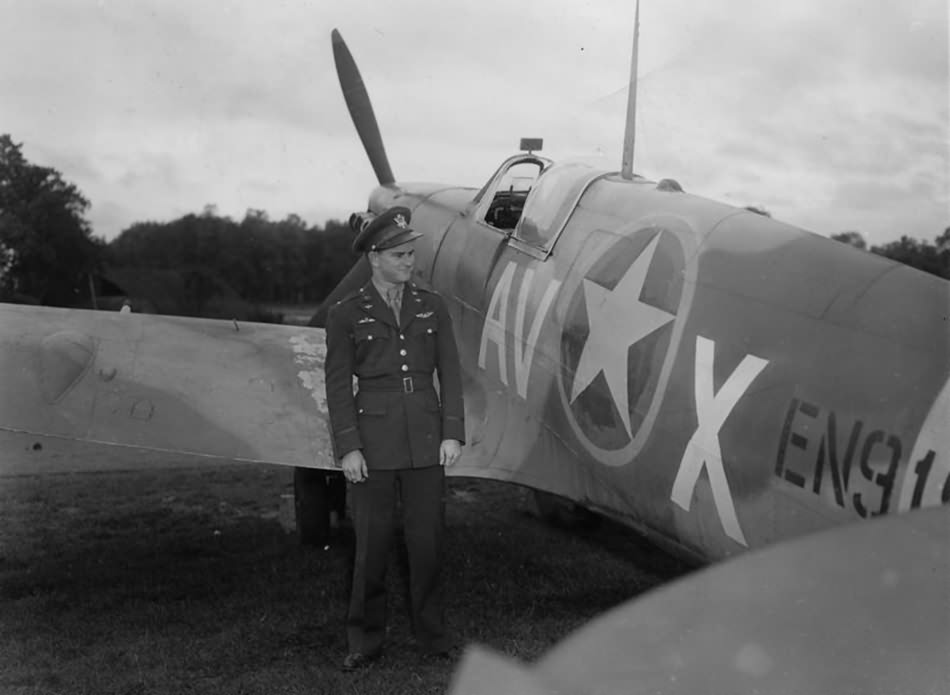4th Fighter Group “The Eagles” – Overview
The 4th Fighter Group of the Eighth Air Force, also known as “The Eagles,” was one of the most famous and effective fighter groups in World War II. It was formed from the three RAF Eagle Squadrons, which consisted largely of American volunteer pilots. The group is renowned for its impressive combat record and significant contributions to the air war over Europe.
Command Assignments
- Assigned to Eighth Air Force: 12 September 1942
- Wing & Command Assignments:
- VIII Fighter Command: 12 September 1942
- VIII Fighter Command, 4th Air Defense Wing (ADW): 30 June 1943
- VIII Fighter Command, 65th Fighter Wing (FW): 7 August 1943
- 2nd Bombardment Division (BD), 65th Fighter Wing: 15 September 1944
- 2nd Air Division (AD), 65th Fighter Wing: 1 January 1945
Component Squadrons
- 334th Fighter Squadron (FS)
- 335th Fighter Squadron (FS)
- 336th Fighter Squadron (FS)
Combat Aircraft
- Spitfire V: September 1942 – 1 April 1943
- P-47C/D Thunderbolt: March 1943 – February 1944
- P-51B Mustang: In combat from 25 February 1944
- P-51D Mustang: From June 1944
- P-51K Mustang: From December 1944
Stations
- Debden: 29 September 1942 – 20-27 July 1945
- Steeple Morden: 20-27 July 1945 – 4 November 1945
- 336th Fighter Squadron at Great Sampford: 23 September 1942 – 30 October 1942
Group Commanding Officers (COs)
- Col. Edward W. Anderson: 27 September 1942 – 20 August 1943
- Col. Chesley C. Peterson: 20 August 1943 – circa 23 December 1943
- Col. Donald J. M. Blakeslee: 1 January 1944 – circa 1 November 1944
- Lt. Col. Claiborne H. Kinnard Jr.: 1 November 1944 – 6 December 1944
- Lt. Col. Harry J. Dayhuff: 7 December 1944 – 21 February 1945
- Col. Everett W. Stewart: 21 February 1945 – September 1945
- Lt. Col. William E. Becker: September 1945 – November 1945
- Lt. Col. Claiborne H. Kinnard Jr. served as acting CO from circa 1 September 1944 to circa 1 November 1944 while Col. Blakeslee was on leave.
Mission Details
- First Mission: 2 October 1942
- Last Mission: 25 April 1945
- Aircraft Missing in Action (MIA): 241
- Enemy Aircraft Claims: 583 in air combat; 469 on the ground
Major Awards
- Distinguished Unit Citation: Awarded for operations from 5 March to 24 April 1944, during which the group destroyed 189 enemy aircraft in the air and 134 on the ground.
Claims to Fame
- Formed from the RAF Eagle Squadrons, which were composed of American volunteer pilots.
- The oldest fighter group in the Eighth Air Force.
- Achieved the highest combined total of air and ground enemy aircraft claims of any USAAF group.
- First to engage enemy aircraft over Berlin and Paris.
- First Eighth Air Force fighter group to penetrate German airspace (28 July 1943).
History
- Formation: Activated on 12 September 1942 at Bushey Hall, Hertfordshire, England. The official ceremony transferring RAF squadrons 71, 121, and 133 (Eagle Squadrons) to the 4th Fighter Group occurred on 29 September 1942. These squadrons became the 334th, 335th, and 336th Fighter Squadrons, respectively.
- Training and Operations: The ground echelon was formed from that of the 50th Fighter Squadron, previously of the 14th Fighter Group at Atcham. RAF personnel trained the USAAF ground echelon in servicing Spitfires. Initially, flying control was still managed by the RAF Fighter Command.
- Return to the USA: In November 1945, the group returned to the United States. It moved to Steeple Morden at the end of July 1945 as the RAF required Debden. The group was gradually run down, and aircraft were flown to depots for disposal. The group sailed on the Queen Mary from Southampton on 4 November 1945, arriving in New York on 9 November 1945. It was inactivated at Camp Kilmer, NJ, on 10 November 1945.
Aircraft Markings and Color Schemes
Spitfire VBs (September 1942 – April 1943)
- Colors: Finished in standard RAF temperate land scheme colors:
- Upper surfaces: Dark Green and Ocean Grey in a disruptive pattern.
- Undersurfaces: Medium Sea Grey.
- Markings:
- British ‘friendly aircraft’ markings: Sky spinner, 18-inch wide rear fuselage band, and 4-inch wide yellow stripes on the leading edges of the outer wing sections.
- US National Insignia: Superimposed on the fuselage roundels, maintaining the yellow surround. Wing roundels were painted out, and US national insignia were centered on the upper left and lower right wing surfaces.
- Squadron Code Letters:
- 334th FS: XR
- 335th FS: AV
- 336th FS: MD
- Letter Colors: Sky, placed forward of the national insignia on the left side of the fuselage and aft on the right. The individual aircraft letter was often painted under the nose in Sky, 6-9 inches high.
